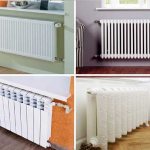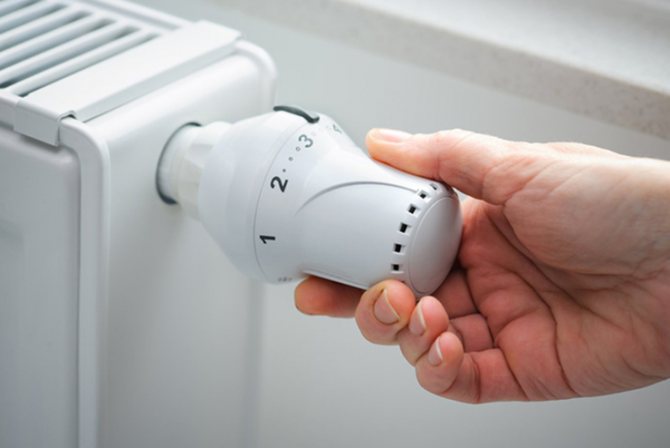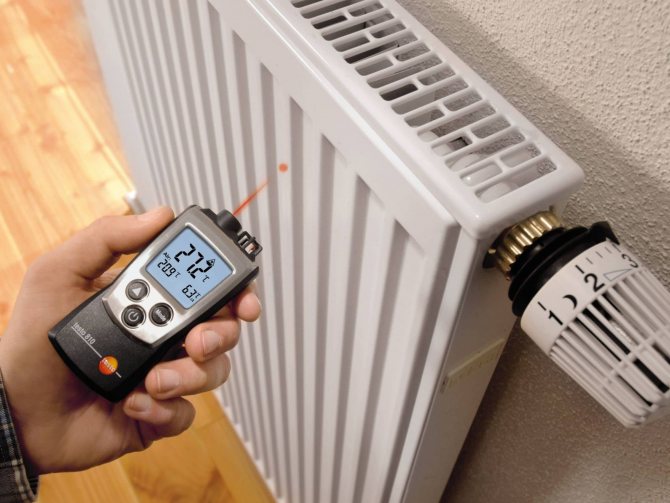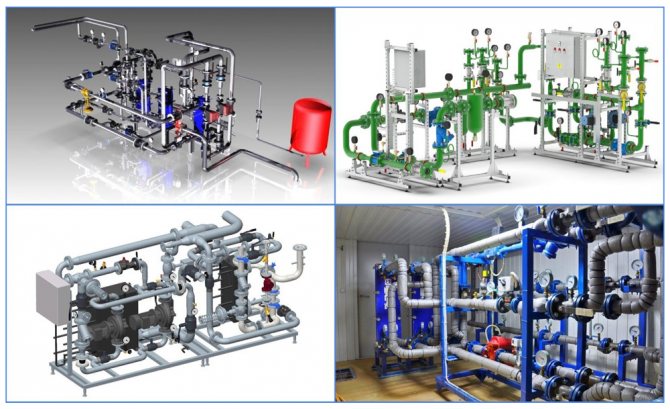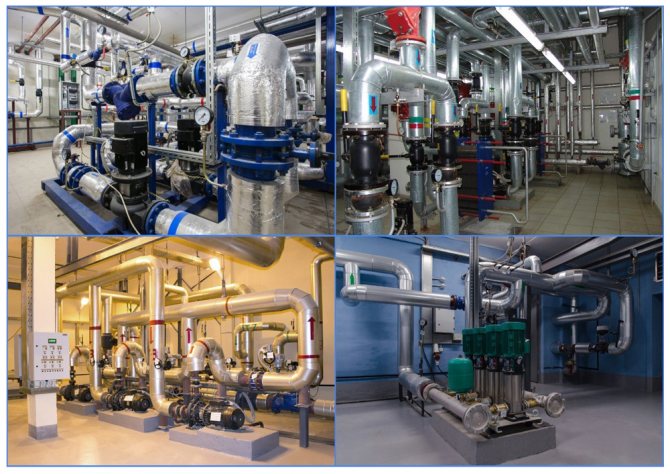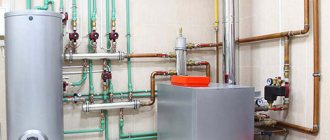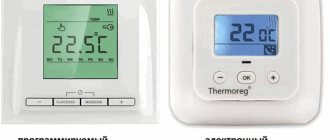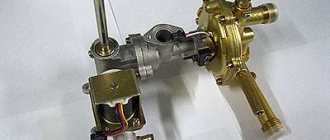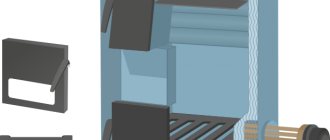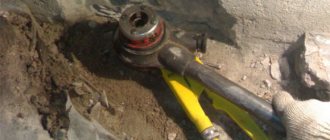Many modern residential apartments are equipped with autonomous heating. There is no question of norms here. Everyone sets the temperature of the water in the radiators at will and pays according to the meter. However, most houses still have central heating, where the temperature in the radiators is regulated by standards. When it gets cold in an apartment, people wonder about the water temperature in central heating batteries.
Radiators according to GOST standards
When heat depends on batteries
Heat supply is regulated by Decree of the Government of the Russian Federation No. 354 dated 6.05.2011. According to this document, the start and end of heating is linked to the ambient temperature. Central heating batteries turn on when the average daily rate drops to 8 degrees above zero and lasts for five days. In the main territory of Russia, this happens by mid-October.

Battery under the window
Water leaves the radiators when the average outdoor temperature reaches +8 degrees Celsius. And it remains so for five days. Battery shutdown times vary by regulation.
In warmer years, this happens at the end of April.
If the temperature is low, then according to the standards, heating of residential and industrial premises remains until mid-May. Only during this period of time should we talk about the temperature standards of water in radiators. The rest of the time, the fight against the cold is the work of the residents.
Factors affecting indoor air temperature
The hot water temperature in the batteries is a normative indicator, which is regulated by current legislation. But the actual air temperature inside the dwelling depends not only on this factor. In the process of design and construction of residential and industrial buildings, most of the criteria for heat transfer and thermal conductivity are regulated by the relevant SNiP (building codes and regulations), as well as sanitary standards (SanPiN) approved by the current legislation. But much in the process of heat exchange and heat saving depends on the owners of the households.
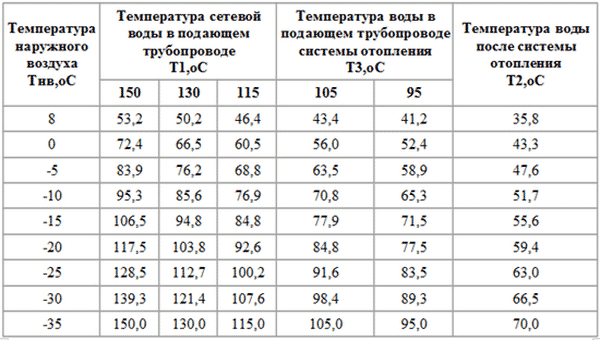

The following factors influence the process of heat exchange in the room:
- optimal water temperature at the inlet and outlet of the heating system;
- heat transfer coefficient and the number of installed heating radiators;
- the degree of air recirculation in the room;
- thermal conductivity properties of building envelopes;
- condition of window and door blocks in the context of heat saving.
Important! According to SanPiN 2.1.2.2645-10 "Requirements for living conditions in residential buildings and premises", the normal temperature regime of air in living rooms corresponds to an indicator not lower than 18 ° С, in bathrooms not lower than 25. The upper temperature limit in an apartment established by this normative act , is 24 ° C. The air temperature on the staircase should be in the range of 14-20 ° С, and in the inter-apartment corridors - 16-22 ° С.
Control measurements of this parameter are made at a distance of 1 m from the wall and 1.5 m from the floor. In the event of a deviation from the standard values, the homeowners have grounds for writing an application to the management company with a request to understand the reasons for the discrepancy.
Water temperature norm
It was once believed that the water for central heating should be heated to 100 degrees at the outlet and 60 degrees in the opposite direction. At that time, there was no good equipment to control the heating of water for central heating. This approach is not cost effective.Rising fuel costs increase utility bills for homeowners.
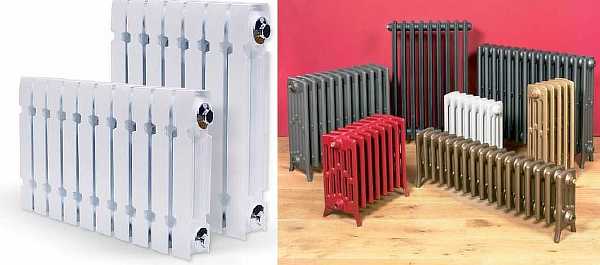

Regulatory radiators
Modern equipment allows the use of low-temperature heating of apartments according to the standards. This means that the norms for the water temperature in the heating radiators are not constant. They become attached to external factors. The following are taken into account:
- Heat loss of buildings. It is theoretically possible to build a house without heat loss. To do this, you will need to overlay it with insulation of at least a meter thickness. In fact, 150 mm of high-performance insulation is considered good thermal insulation. But heat loss will still go through the walls, floor and roof. The higher these losses, the more heating the dwelling needs to create a comfortable environment.
- Heat source indicators. If the boiler does not meet the design requirements, then more water heating is required for heating.
- Heat transfer of the metal from which pipes and batteries are made. If the metal of the pipes has a low thermal conductivity, then this will allow not to lose heat during transportation from the heat source. Batteries, on the other hand, must have a high thermal conductivity in order to give off heat to the maximum. Cast iron batteries have lower thermal conductivity compared to aluminum and bimetallic ones. For the same heating, the water temperature must be higher in cast iron.


Installation of a heating battery according to standards
When assessing the comfort of housing, the temperature in the heating system is not the main indicator. Temperature standards refer to the state of the atmosphere in the apartment.
The temperature of the heating batteries in the apartment is normal
What is the normal temperature of the heating batteries in the apartment?
During the heating season, the optimal temperature of the heating batteries in the apartment should be maintained, the norm of which is regulated by Decree No. 354 of the Government of the Russian Federation dated 06/05/2011. ... The goal is to maintain the standard air temperature in residential premises. But often these standards are not respected for various reasons, and residents have to solve the problem on their own.
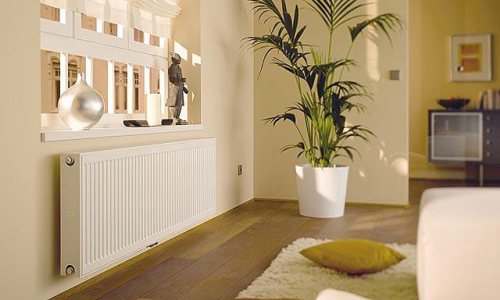

Requirements for heating networks
With centralized heat supply, the source of heat is a boiler house or a CHPP, where hot water high-temperature boilers are installed (at CHPP - steam). Natural gas is usually used as fuel, other energy carriers are used to a lesser extent. The temperature of the coolant at the outlet of the boiler is 115 ° C, but the water does not boil under pressure. The need for heating up to 115 ° C is explained by the fact that boiler plants operate with maximum efficiency in this mode.
The transition from 115 ° C to the required temperature value is provided by plate or shell-and-tube heat exchangers. At the CHP, waste steam from the turbines is fed to the heat exchangers to generate electricity. According to regulatory requirements, the water temperature in the heating pipes should not exceed 105 ° C, the lower limit depends on outdoor conditions. In this range, water heating in the heating network is regulated depending on the weather, for which there is a temperature schedule for the heating system in each boiler room. For house networks, 2 calculation schedules are used:
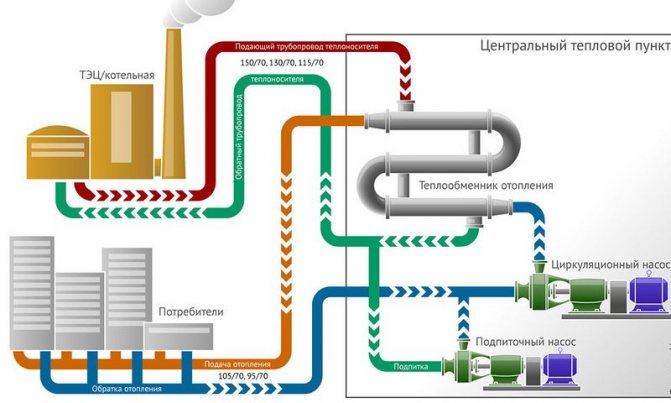

These figures show the maximum temperature of the supply and return water during the most severe frosts in a particular area. But at the beginning and at the end of the heating season, when the weather is not yet too cold, it makes no sense to heat the coolant to 105 ° C, so a real temperature heating schedule is drawn up, where it is written to what extent the water should be heated at different outdoor temperatures.The dependence of heating on weather conditions is shown in the table, where excerpts from the graph for Ufa are presented:
outdoor air daily average


The table is presented as an example and is true only for this city, in another locality its own dependence operates, because the climatic conditions on the territory of the country are different.
It is rather difficult to find out exactly what the temperature of the coolant is in the centralized heating network. To do this, you need to have a remote thermometer that determines the degree of surface heating. So it is possible to determine how much the heating standards are being observed in the apartment only by the air temperature in the rooms.
Heating requirements
According to the aforementioned Decree, the start of centralized heating is carried out after 5 days, during which the average outdoor temperature does not exceed +8 ° C. If, after 4 cold days, heat returns on the fifth, then the beginning of the heating period is postponed until the specified conditions are met. Heating standards prescribe that the cessation of heating operation occurs according to the same principle: 5 days must pass with an average daily temperature of +8 ° C.


There are changes in the Decree that provide for an individual approach to the supply of heat to buildings that fully comply with the requirements for thermal insulation. Heat supply organizations are required to turn on the heating of such houses as soon as the outside temperature drops to the value specified in the design documentation. It is easy to guess that, in fact, these changes are not performed very well, and the heating supply is launched simultaneously in all residential buildings - insulated and ordinary.
During the heating season, the district heating system must provide apartment buildings with sufficient heat energy. In order for the heat supply service to be considered fully rendered, the following requirements for the permissible air temperature in rooms for various purposes must be observed:
- living rooms - from 18 to 24 ° С, corner rooms - from 20 ° С;
- bathroom (or separate toilet and bathroom) - from 18 to 26 ° С;
- kitchen (taking into account the heat source in the form of a stove) - from 18 to 26 ° С;
- pantry - from 12 to 22 ° С;
- corridor - from 16 to 20 ° С.


For apartment buildings located in cold northern regions, the lower limit of the permissible temperature in living rooms has been increased to +20 ° С (in corner ones to +22 ° С). The increase takes effect provided that the frost on the street reaches -31 ° C (on average per day) and lasts at least 5 days. It is also allowed to reduce the temperature in the apartment by 3 ° C starting from midnight and ending at 5.00 in the morning.
Heat supply to a number of apartments or the building as a whole may be interrupted as a result of an emergency and unforeseen repairs. But for repair work, regulatory documents allocate a certain time, depending on weather conditions. The colder the outside air, the sooner the relevant service is obliged to remedy the malfunction. The total duration of interruptions in heating operation is no more than 24 hours per month.
Failure to comply with the requirements of the heat supply organization
When the duration of repair measures exceeds the time allocated according to the norms, the heat supplier is obliged to recalculate the payment, its value is reduced by 0.15% for each extra hour of disconnected heat supply. According to the rules, the same recalculation must be carried out for the entire time when the temperature in the apartments was less than the permissible one (18 ° C). In this case, the deducted amount of payment cannot be more than the amount for the entire period when enough heat was not supplied to the radiators for heating. In some cases, the regulation allows full exemption of affected residents from payment.
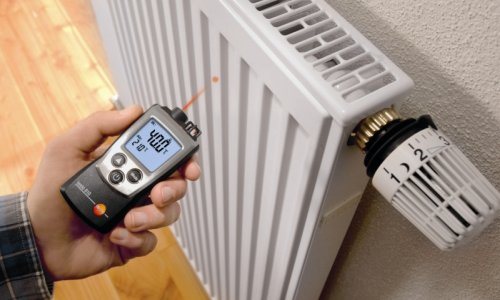

In order to obtain the discount provided for by legislative acts, residents of an apartment building must complete a number of formalities:
- After taking measurements of the air temperature, report the violation of the standards to the dispatch service of the heat energy supplier. It is best to draw up a written statement signed by the residents of the apartment.
- The application must be registered in the prescribed manner.
- According to the rules, after a complaint has been received, a check must be made by the caretaker within 2 hours. They are obliged to visit the dwelling and check how many degrees are in the apartment at the moment.
- Based on the results of the inspection, an act is drawn up, signed by the inspectors and the injured party. If necessary, an additional examination can be appointed, the cost of which is paid by the heat supplier. But if the examination concludes that the standards are not violated, its cost will be included in the payment for heat energy.
- 07/13/2016 Heating a private house with your own hands - choosing a suitable scheme
- 07/04/2016 How to choose a collector for heating?
- 08/29/2016 Causes of noise in the heating system of a multi-storey building
Practice shows that employees of a heating network enterprise may not come with a check or visit them does not bring results. In such a situation, the act is drawn up independently and endorsed by at least 2 users of the services, and then by the chairman chosen by the council of the owners of the apartment building. A copy of the act is officially transferred to the heat supply organization and is registered there. The provision of a low quality service is considered from the moment when the act is signed by all parties.
Further failure of the enterprise to fulfill its obligations leads to litigation, where the previously drawn up act, which has legal force, will play an important role. Such actions in relation to unscrupulous heat suppliers are necessary to induce them to reconstruct worn out networks and equipment; it will be more expensive to pay for claims.
see also
What should be the temperature in the apartment - norms
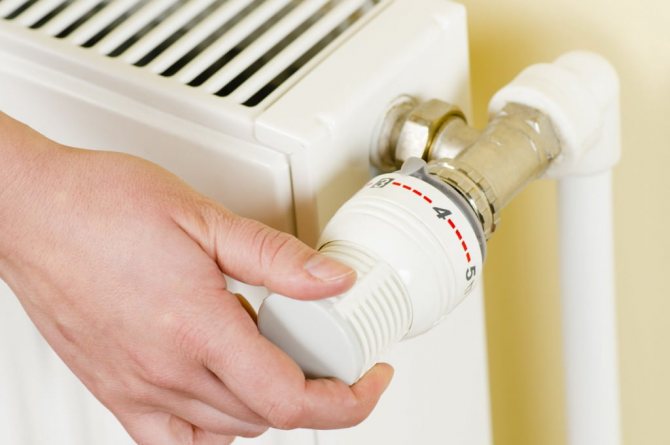

The t in the dwelling is influenced by:
- Climate.
- Seasons.
- Individual characteristics of housing.
Normal temperatures may vary from area to area. For example, in the southern and northern regions, in the eastern and western regions, its numbers differ.
Due to the alternation of the seasons, the microclimate also changes. In summer, the temperature rises significantly and decreases in winter.
Housing planning also affects the maintenance of a comfortable stay. For example, in a corner apartment, the degree of warmth is slightly lower.
The human factor is also involved in the creation of temperature characteristics. Each person has his own concept of warmth and coolness. Women are naturally thermophilic, they need a slightly higher temperature than men. Small children do not know how to support their bodies on their own t, they can easily overheat and overcool, which negatively affects their health.
Temperature regulation is carried out in accordance with GOST and the rules of the organization providing utilities.
- T is considered comfortable from 20 to 25 ° С.
- During the cold weather 19 - 22 C.
- In the heat 22 - 25 C.
Temperature range of different rooms:
Do not create sudden changes in heat between rooms, no more than 2 °.
Heating season
In the Government Decree No. 354 of 06.05.2011, the heating period is clearly indicated.Based on this decree, heat enters our homes with a persistent decrease in ambient temperature below eight degrees for eight days.
On the sixth day, we may not wait for the relying service if:
- No preliminary preparation of heat supply networks has been made. Usually, all repair work is carried out in the summer.
- Accident. From a sudden breakdown, preventive measures can be powerless. Many factors, such as severe winter frosts or huge summer heat, contribute to the rapid deterioration of communications.
The standard is designed for apartments with centralized heat supply. Having individual heating, you can not wait for the start of the season, but regulate the temperature in the house yourself.
The beginning of the heating season does not have a constant date in our country. Depends on natural factors. Severe cold weather can occur in early autumn or mid-autumn.
The approximate date for the start of heat delivery is the end of September and the middle of October.
What temperature should be in a corner apartment
The temperature in the corner apartment should be two degrees higher than that of the others and is 20 degrees, the base one is 18. To maintain the given figure, in cooler corner housing, an additional battery is introduced into the project even before construction.
Optimal t mode:


What temperature should be in batteries
The temperature in our batteries is constantly changing, it mainly depends on changes in the weather, but it is never higher than 90 degrees, this is enough to maintain comfortable conditions even in severe frosts. The main radiator is of the appropriate brand with the required heat output.
Typically, throughout the year, the water is heated to 50–70 degrees, in the summer it is supplied to the tap marked "for hot", and in the winter to the heating system.
The easiest way to measure:
- Place the thermometer in a container.
- Fill with hot tap water.
Deviation is allowed only up to 4 degrees.
Other measurement methods:
Constant thermometry device:
- Choose the most suitable place on the radiator.
- Put on the most common alcohol thermometer.
- Fix for thermal insulation with foam rubber.
Fast, inexpensive, convenient and regularly monitored.
Important. If the temperature does not correspond to the specified norm, file a complaint with the housing and communal services. The arriving commission will determine the temperature of the water in the heating system. They are obliged to act in relation to paragraph 4 in the "Methods of control" GOST 3049-96. The measuring device has a quality certificate, registration and verification. The error in its work is not more than 0.1 degrees.
How to fix problems
Heating problems are immediately apparent. Cold and constant dampness, the appearance of fungus on the walls. There can be no question of any comfortable living for the human body.
The main signs of problems are:
Barely warm batteries are the biggest sign of your problems.
Reasons for the situation:
- Incorrect design.
- Incorrect hardware installed.
- Unauthorized connections.
- Not a high-quality installation of the system.
- Air in the pipes.
- Violations when installing radiators.
- Pipe wear.
- Lack of tightness of connections.
Step-by-step instructions for troubleshooting
- Layout.
Important! Do not wait for the beginning of the heating season, inspect all pipes and radiators in your apartment in advance.
Do not skimp on equipment; repairs to your neighbors' flooded apartment will cost more.
Not all plastic pipes are suitable for installing heating, they can melt or burst from hot water.
Recalculation of payment for heating
If the temperature in the apartment does not meet the specified standards, you must submit your requirements in writing to the housing and communal services. Within two days, a special commission, after inspecting the housing and measuring the temperature in the batteries, will confirm the violation.
With a temperature regime in the rooms of 14 degrees Celsius, citizens have the right not to pay for this utility service. And the relevant organizations are obliged to recalculate, guided by Appendix 1 of the Decree of the Government of the Russian Federation of May 23, 2006 No. 307 "On the procedure for providing public utilities to citizens."
Recalculation is made in such cases:
- The daytime temperature of the living room is less than +18, for the corner room is +20.
- The frost is -30, and the heating rates are not increased to + 20 and +22, respectively.
- The total shutdown time during the month is above 24 hours. It should be noted that interruptions in heat supply must be recorded. You can't prove anything without paper.
- One-time shutdown at external t -12 more than 16 hours.
It is also necessary to submit an application for recalculation:
Recalculation will be refused if:
Recalculation is possible once a year. Before starting the procedure, carefully weigh the pros and cons. The process is lengthy and requires a lot of documents. Careful preparation is needed.
Heating system flushing system - basic models
What should be the temperature of the batteries during the heating season
Heating of apartments in multi-storey buildings is the prerogative of an authorized company or homeowner.
If you managed to get permission and make individual heating of your home, this is an indisputable plus.
In this case, you can, on your own, regulate the temperature in the living quarters and be at the same time not dependent on anyone.
With a centralized heating method, everything is much more complicated.
Heating standards for heat carriers
On the basis of sanitary standards, norms have been established regarding the heating system in apartment buildings of a residential type.
As a basis, take into account the needs of the average adult.
The calculation itself is quite complicated, and only specialists of a certain level can carry it out.
They are established and approved at the legislative level and are spelled out in the SNiP.
If you feel cold in your apartment due to cold batteries, you need to know what temperature should be in the batteries in winter, in order to contact the appropriate authorities in case of non-compliance with the standards.
Do not forget that a lot, in this case, depends on:
- outside air temperature,
working fluid temperature,
If you have any questions to the representatives of the service organization, you can write a statement and invite the engineer of the housing office for measurements, who, with the help of special devices, will perform all the necessary actions.
Thus, he will find out the temperature of the batteries in the apartment, its rate may fluctuate slightly in one direction or another (depending on the weather outside).
And what do you know about a plastic caisson for a well, the price of which is approximately indicated in a useful article. Read on for what purposes it can and should be used.
How the automation of water supply from an artesian well is carried out is written on this page.
Do you know what a hydraulic seal is for sealing leaks in concrete. Its chemical composition and methods of sealing cracks in reinforced concrete rings used in the construction of wells are described in a useful article.
Watch a video about installing casing pipes in a well here.
After all measurements have been made, the specialist draws up an act, one copy of which he keeps for himself, and the other is given to the owner of the apartment.
Based on the results of the check, utilities are obliged to fix the problems in a short time.
At the same time, each owner of an apartment or house in which inconsistencies are found may require that he recalculate the payment for low-quality heating services.
The fee is reduced in proportion to the square of the apartment .
One of the most important factors in a warm house is the temperature of the working liquid substance in the radiators supplied by the circulation pump to the heating system (installation diagram).
According to the established standards, a coolant must be supplied to the batteries, the heating level of which varies from eighty to eighty-five degrees Celsius.
Temperature measurement techniques
If you take measurements with an ordinary thermometer, you will need to add a few more degrees to the indicators.
The most accurate readings can be found using an infrared device - a pyrometer. Its error is no more than 0.5 degrees.
For regular temperature monitoring use only the safest device - an alcohol thermometer.
For these purposes, it is attached to the radiator with adhesive tape and wrapped in heat-insulating material.
How to use the electric thermometer option ?
You need to take a wire with a thermocouple and tie it to the heating device. In this manner, the indicators are taken.
If a commission has come to your apartment to measure the temperature of the batteries, they must have a certified device.
You have the right to demand from the representative of the inspecting organization, documents confirming that the equipment has passed state verification.
The heating system has very serious requirements. .
The process of delivering hot coolant by circulating pumps (the rules for installation in the heating system are written here) to a residential building and its uniform distribution across all apartments is not an easy matter.
It is necessary to approach this issue responsibly and with an understanding of all the technological subtleties.
In order for the heating system to work efficiently, all of its elements must function harmoniously.
This applies to all pipes and batteries.... in each of the apartments of a multi-storey building.
Therefore, when replacing radiators (read how to install heating batteries in a private house in this article), you need to take into account the peculiarities and subtleties of the heating main.
If this is not done, some apartments will experience an overabundance of heat, while not the best times will come for the residents of other apartments (they will have cold batteries ).
How can optimization be achieved heating urban dwellings?
Answer: by introducing the following norms :
- in the safety regulations it is said that the temperature of the working liquid substance in the heating main should be 20 degrees lower than the temperature of self-igniting materials.
For residential multi-apartment buildings the coolant limit has established norms - 65 - 115 degrees Celsius (this is taking into account the seasonality);
In case this indicator is exceeded, a restrictive structure must be installed on the battery (about the ways of distributing heating in a private house it is written here);
In some cases, these standards can be changed.
Service providers should be guided by the average daily outside temperature.
Where to complain if the apartment is cold
Before going in search of warmth, it is worth remembering the following:
- hot water starts to be supplied to our apartments through the central heating system only when the outside temperature reaches certain values.
According to the regulations, the heating season can start under one condition: for five consecutive days, the external temperature is kept at no more than +8 degrees.
In this case, heat must be supplied to our home.
If the heating throughout the house is functioning properly... and only your apartment remains cold, which means that the problem lies in a particular apartment.
Then, first of all, it is worth checking if your heating system is not air-conditioned.
To understand this, it is enough to probe individual sections for heating.
If the batteries are warm, in parts, then the reason is most likely airing.
The air from the system can be released by means of the Mayevsky crane... which should be installed on radiators in each room (see options for installing radiators in an apartment here).
Before opening the valve, you need to substitute a basin or bucket under it.
When the coolant starts to leave the tap without a characteristic hissing sound, this means that there is no air in the batteries.
After that, the tap must be closed and after a while the batteries must be checked, they must warm up evenly.
Established norms for hot working fluid in the centralized heating system the following:
- plus fifty - plus seventy-five degrees Celsius at the point of water intake.
If, for some reason, these figures go down to forty-five degrees, consumers are entitled to a ten percent discount when paying for heating.
If the hot water temperature is only forty degrees, you are entitled to a 30% discount.
When the temperature readings are below forty degrees - the service is not payable .
If the relevant services do not respond to your complaints, you can take measurements yourself in the presence of your neighbors.
To do this, you need a device such as a pyrometer. .
The act can be drawn up in any form, the main thing is that the document contains the signatures of the people who were next to you during the measurements.
Remember! The guarantee of your health and everyone living in this apartment largely depends on the optimal microclimate in the living space.
And to create it and maintain it at the proper level is within the power of every homeowner.
It is very important to create an ideal microclimate in an apartment. The air should not be too dry.
For each individual room, there are norms for the amount of fresh air.
Some experts believe that they are a little overpriced. But, if the air exchange in your apartment is half of the established standards, this is considered quite acceptable.
Watch an excerpt from the TV program on the standards for heat supply to apartments.
- The temperature of the heating batteries in the apartment is the norm. What is the temperature of the heating batteries in the apartment? During the heating season, the optimum ...
- Do-it-yourself repair of heating batteries Repairing heating batteries can consist in replacing them with new ones, changing the number of sections, flushing, or ...
- Standard for the temperature of the heating batteries in the apartment What is the normal temperature of the heating batteries in the apartment? During the heating season, the optimum ...
- Regulation of radiators in an apartment Methods for adjusting radiators of a heating system using taps, thermostats and servo drives During professional design ...
Pyrometer and how to work with it
A pyrometer is an infrared thermometer. He determines the temperature by electromagnetic radiation. An accurate engineering device allows you to quickly measure the temperature of an object located at a distance not exceeding three meters from the device.
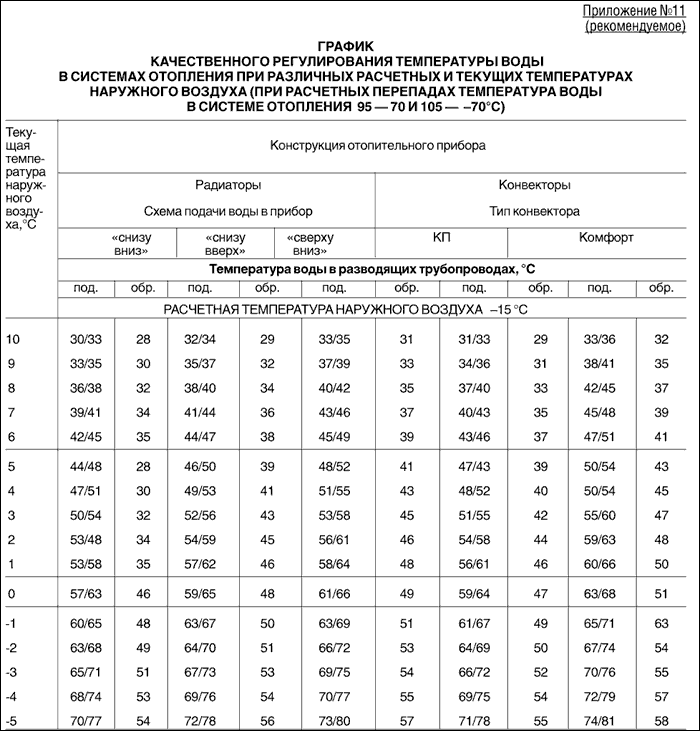

Heating rates
But even this excellent equipment is capable of giving errors, which is what negligent utilities use. When measuring the temperature, the readings of the device will be erroneous if:
- in a relatively small room, there are many objects made of various materials;
- the room has high humidity or a lot of dust;
- the temperature of the device differs significantly from the temperature of the room;
- the distance to the measured object exceeds 3 m;
- the room is very large.
How to measure battery temperature
You can measure the temperature of the radiators as follows:
- A container is placed under the drain tap, for example, a basin, and a thermometer is placed in it.
- The valve is opened and the volume is filled with water.
- Waiting for the response of the device.
The obtained temperature value may deviate from those presented in the table above. 1 degree down or 3 up. For example, if according to the documents in the radiator 85 degrees, it is allowed 84—88. With a greater temperature drop, it is necessary to write an appropriate act to the management company or heating service provider. The same goes for excessively large numbers.
There are 5 ways to check the temperature in total:
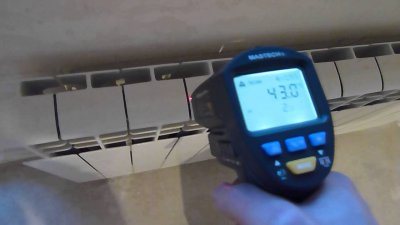

- presented above;
- just applying the thermometer to the pipes (add to the result two degrees);
- use of an infrared pyrometer: it is sent to the strapping and waiting for the result, the error is about 0 ° C;
- an alcohol thermometer is wrapped in a heat-resistant material, for example, foam rubber, and glued with tape to the battery, then throughout the day readings are taken every hour;
- use an electrical meter, fixing the sensor to the harness.
Along with the temperature, check the system pressure by installing a pressure gauge. If the indicator exceeds 2 atmospheres, you need to file a complaint about the airing in the housing office.This problem is also easy to spot when draining the water.
How to adjust and increase heat dissipation
To change the temperature of heating radiators, special regulators must be installed on them. There are 4 types of such devices: shut-off valves, manual valves, automatic thermostats, radiator thermostats.
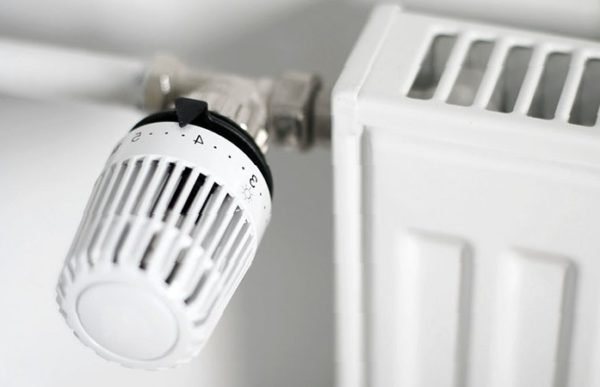

Photo 2. Manual thermostat for the heating battery. By turning the knob, a suitable temperature can be set.
In order to increase the temperature of the radiator, it is necessary to open the regulator and let in more coolant into the heater... Conversely, in order to lower the temperature, it is necessary to drain the excess coolant.
What determines the weather in the house
Modern equipment allows, without much human intervention, to maintain the norms for supplying hot water to heating radiators. But the number on the device is one thing, and the real warmth in the apartment is quite another. The final result depends on many parameters:
- The climate of the area of residence. In Moscow, with a drier climate, the cold is felt less than in St. Petersburg with its dampness.
- Thermal conductivity of the structure. Houses built of bricks have less thermal conductivity than block houses. As a result, the temperature of the water in the heating radiators can be lower due to less heat loss.
- The location of the apartment in the house. Corner rooms freeze more than apartments located in the center of the house. Heat loss in heating radiators will be greater.
- Decoration Materials. Walls covered with heat-saving wallpaper retain heat longer. This reduces heat loss from radiators and central heating radiators.
- Heating radiator material. Cast iron batteries give off less heat than steel ones.


Temperature norm in external networks
All these indicators will affect the atmosphere in the house, regardless of the heating temperature standards. It also doesn't matter how hot the radiators or batteries are in the apartment.
Maintained temperature
The temperature of heating batteries in residential apartments in centralized heating is determined according to the relevant standards, which display a sufficient value for premises, depending on their intended purpose. In this area, the standards are simpler than in the case of work premises, since the activity of residents is, in principle, not so high and more or less stable. Based on this, the following norms are regulated:
- In residential premises, temperature fluctuations should be in the range from 20 to 22 degrees (the permissible limit is 18-24 degrees Celsius);
- For corner rooms, indicators of at least twenty degrees are applicable, since it is these rooms that are most exposed to low external temperatures;
- In the kitchen, since this is a working room with a heat source (gas or electric stove), temperatures can range from 19 to 21 degrees Celsius (on average from 18 to 26);
- The toilet should have a temperature similar to that of a kitchen;
- For bathrooms, as for hot rooms, it is normally considered from 18 to 24 degrees (maximum 26);
- Non-residential premises should have a temperature depending on how often they are used, so for the corridor it is standard 18-20 degrees, but not less than 16, in the storeroom - 16-18, but it is permissible from 12 to 22 degrees.
Of course, the individual characteristics of each person should be taken into account, everyone has different activity and preferences, therefore there is a difference in the norms from and to, and not one single indicator is fixed.
Fight for warmth
It is better to think about possible heat loss of the home in the summer. But if this was not done, then it is possible to insulate the house with the onset of winter. The first thing to do is to identify weak points where heat loss is possible.
Windows by norms
The main source of cold is windows. Nowadays, there are double-glazed windows almost everywhere above radiators and radiators. But even plastic window frames are aging.The sealing rubber becomes unusable.
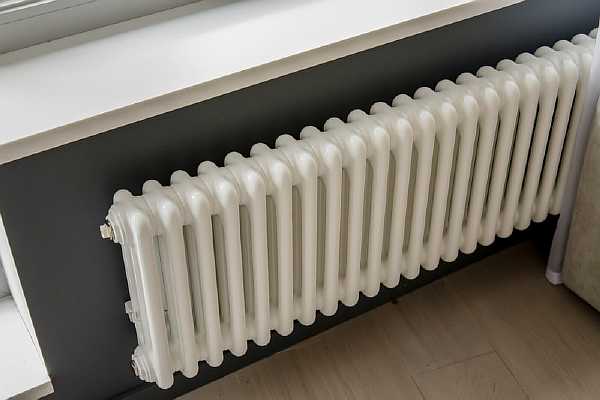

Central heating in the apartment
The windows are starting to let in the cold. The easiest way is to stretch plastic wrap over the frames. It is sold in rolls in stores. This material has no effect on the transparency of the glass. Heat loss in radiators or radiators will decrease.
The film is fixed to the glass. Before this, the frames are thoroughly washed. Double-sided tape is glued around the perimeter. A film is attached to it. It is easier to do this together.
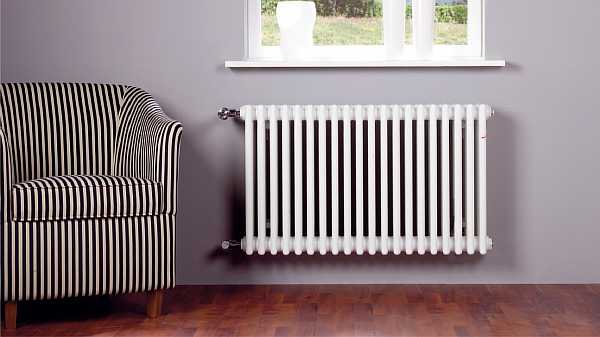

Battery on the wall
If wrinkles have formed on the coating, the film is heated with a hairdryer until they are straightened out. Then it remains to glue the frames. Do it with one-sided tape. This simple method helps to retain up to 20% of the heat.
You should open the curtains and open the blinds every morning. The apartment is perfectly warmed by the sunlight that enters the room through the glass. Double glazed frames create a magnifying effect, enhancing the warmth of sunlight. When it gets dark, the windows should be closed. In the dark, glass draws heat from the room.
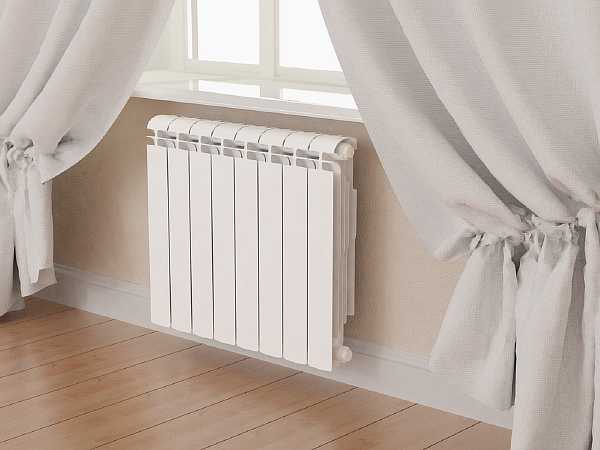

Radiator under the center window
Weather dependent
The basis of the temperature graph is the correlation between the temperature of the water supplied from the CHP and the temperature of the outside air. The lower the thermometer goes down, the colder the enclosing structures (floors, walls) become, and the more energy is needed to heat the air in the room and the inner surfaces of these structures. So, for example, for walls, the regulated temperature difference on their surface and the air in the room is 4 ° C.
When calculating schedules, the beginning and end of the heating season are taken when setting the average daily temperature:
- 8 ° С in regions with an estimated air temperature of up to -30 ° (in these areas, the average indoor temperature is taken as 18 ° С).
- 10 ° С for areas with the coldest five-day period below -30 ° С (average indoor temperature 20 ° С).
When the wind increases, heat loss increases through the filling of window and door openings, which should also be reflected in the planning of the CHP plant. In addition, when designing heating networks, it is necessary to take into account losses along the entire heating main, which has an average length of about 10 km.
Heat calculator
Almost every home already has a special device called a heat calculator. Its task is to calculate how much heat was taken by your house. Unfortunately, due to historical reasons, when we had everything in common, and therefore no one, we are not used to counting heating costs. Meanwhile, today heating is the most expensive column of expenses in bills. Moreover, due to the fact that historically no one counted heating in our country, this area is now the most bribe-intensive and extremely ineffective. And in order to somehow correct the situation, everyone who is interested in what numbers they are exposed to in utility bills must remember and understand the main formula in housing and communal services
:
Namely, according to this school formula, the heat meter calculates the cost of heating for you: m is the mass of the coolant that passed through your house in 1 hour, dT is the temperature difference between the supply and return. Those. at the entrance, for example, 80 degrees, the coolant passing through the heating batteries of the house cools down to 50 degrees - dT is equal to 30 degrees. Multiplying the mass of the coolant by the temperature difference, we get the same Gigacaloria.
Each region has its own price for 1 Gigacaloria, for example in my Vladimir it is 1987 rubles 40 kopecks. The Q obtained for the month is multiplied by the tariff, then divided by the total living area of the house, and we get the cost of heating per 1 square meter. Well, how many square meters you own, as a matter of fact you are obliged to pay.Here is such a rather simple scheme, which many in our country do not even suspect, including, to everyone's surprise, even those who are engaged in this very housing and communal services (as my practice has shown).
Only by understanding how a heat meter works and from what the price for heating is formed, you can deal with energy saving issues. And as the formula shows, you can save either on the temperature difference or on the mass of the coolant passed through the house. Here it is necessary to make a reservation, just like that, it is impossible to take and put the supply into the return, if the house does not take heat at all, and the difference in supply and return temperatures is less than 3 degrees, such a heat meter is removed from the register and the house is charged according to the standard. This feature of the city's heating network, which we will not touch on now.
We go down to the basement
Well, now we come to the fun part. Most modern heat calculators are very modern devices, the capabilities of which are not used at all, in view of the fact that the houses are run by Vasya's plumbers from the distant past and the grandmother from the HOA. I urge all IT specialists not to be lazy and go down to the basement of your house and look at this very interesting computing device.
For example, there was a Thermotronic TV7 heat calculator in my house:


This device has quite large capabilities, such as connecting via Ethernet, USB, RS-232, but most importantly, it has an SD card reader. You just need to insert an SD card into it, and it will automatically record the entire history of readings - pressure, temperature, coolant volume and other characteristics necessary to calculate the cost of heating. By the way, in my case, it also turned out that if native flowmeters were used (a sensor that calculates the mass of the coolant), then it would be possible to automatically record leaks in the house and send SMS to the plumber - you have a flood, run into the house! And so we downloaded the data from the heat meter, and now, using the Archiver program, we can process the data from the counter:
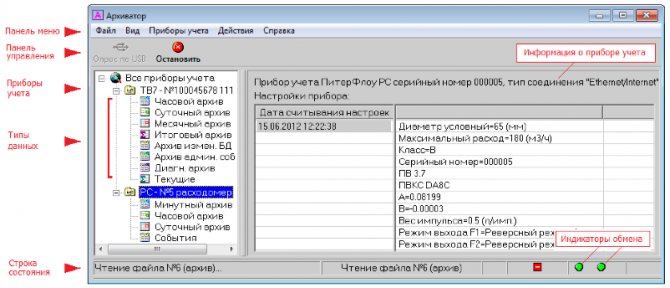

The program itself is quite primitive, and does not even know how to build graphs, and does not even export to Excel. But the good old ctrl-c ctrl-v makes it easy to deal with the problem!
Drawing graphs
Now that we have the data in Excel, we can draw graphs and draw some conclusions. Oh, how much you can see on the charts! For example, in the first graph, there are two subsidences in the volume of the coolant (upper dark blue and gray lines) passing through the house, this is most likely pipe failures in the area. Just coincides with an increase in the supply temperature (frost!)
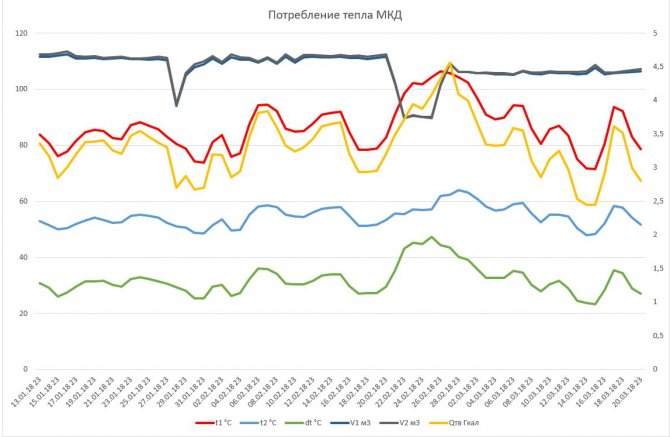

The right axis is Q, which shows heat in giga calories per day. As I said, at the rate of 1 Gigacaloria in Vladimir costs 1987.40 rubles. On the graph, Gigacalories are marked with a yellow line. This is how many gigacalories the house will accumulate in a month, this amount is multiplied by 1987.40 rubles, then it is divided into apartments and you pay it in your receipts for a communal apartment. The red and blue lines are the flow and return temperatures. Values on the left scale. The green line is the delta, i.e. that temperature, how much your house took for heating. As you can see, the serving temperature in cold weather is above 100 degrees. And if it breaks through, it is life-threatening!
It can be seen that despite the jump in flow temperature, the return temperature is always approximately the same. This is an interesting phenomenon. Does anyone know why? I have a version, but I'll leave it with me for now, go to the comments!
It's a shame, in fact, you can't save on the obvious, on the temperature difference. The dark blue and gray lines are the volume of the coolant passing through the inlet and outlet, respectively, per hour. For some reason, we have a little more that leaves than comes. Either there is a measurement error, or something is flowing somewhere ... I will understand this issue.
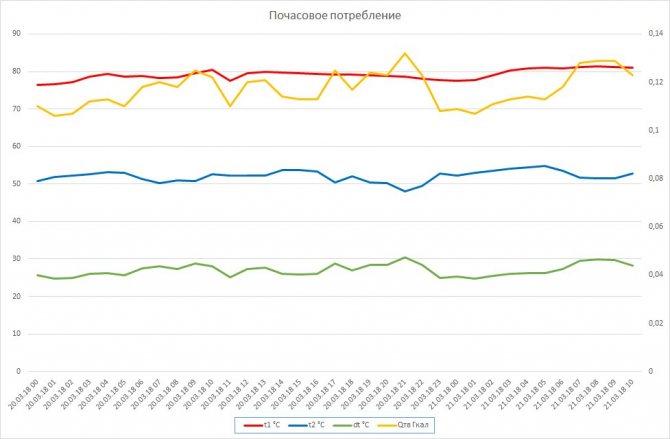

And the second figure is the hourly consumption for the last 24 hours. Here, basically all peaks in giga calories (orange line) are associated with home life.They get up at 7 am, lunch at 12, dinner at 17, and around 9-10 pm everyone takes a shower and actively pouring hot water. What disciplined neighbors I have!
Well, now that it is possible to track the heat consumption of an apartment building, the question of energy efficiency can be raised. First of all, I plan to wrap all the pipes in the house in energy flex, as well as install weather-dependent automation, remove the prehistoric elevator assembly from the circuit, install a modern three-way valve that can be controlled automatically or via the Internet. I do this whole thing with thermal imaging control. I think I will also publish a few posts about the thermal imager if the audience accepts this topic. Well, in general, I plan to tackle the issue of energy saving in full, since at the moment the energy consumption readings at home are extremely high, which we can clearly see on the graph. Tags:
- housing and communal services
- heat calculator
- smart House
- excel
Add Tags
- Smart House
Specify the reason for the minus so that the author can correct the errors. Submit anonymously. Tag the post with your tags. Separate the tags with a comma. For example: programming, algorithms Save We had several data centers in different cities, a narrow communication channel and 2 months to move How did we get out? Advertising
